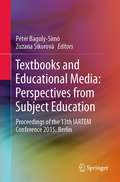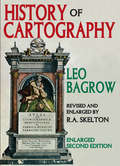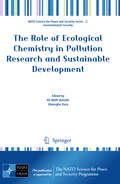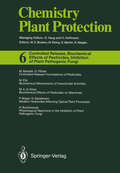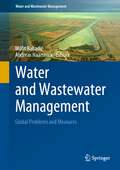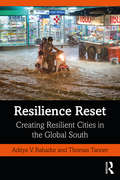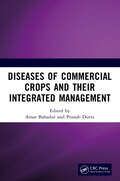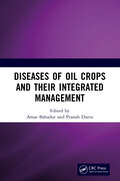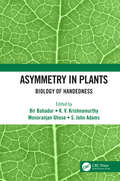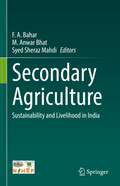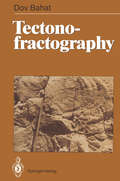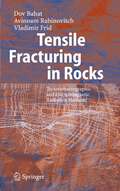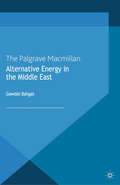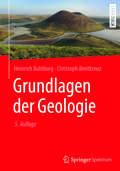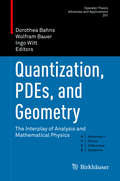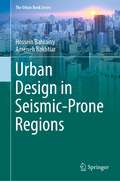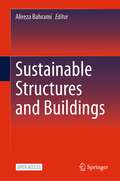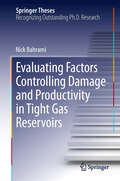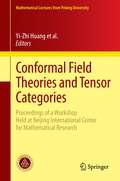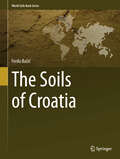- Table View
- List View
Device Applications of Nonlinear Dynamics (Understanding Complex Systems)
by Salvatore Baglio Adi BulsaraThis book is devoted to applications of complex nonlinear dynamic phenomena to real systems and device applications. In recent decades there has been significant progress in the theory of nonlinear phenomena, but there are comparatively few devices that actually take this rich behavior into account. The text applies and exploits this knowledge to propose devices which operate more efficiently and cheaply, while affording the promise of much better performance.
Textbooks and Educational Media: Proceedings of the 13th IARTEM Conference 2015, Berlin
by Péter Bagoly-Simó Zuzana SikorováThis book brings together empirical research and conceptual work on textbooks and education media from 13 countries and 17 disciplines. Along with textbook production, usage, and development, it also explores the interconnectedness of (educational) policy and teaching and learning materials. Further, the book offers insights into regional and local discourses (e.g. specific theories of Portuguese- and Spanish-speaking countries as well as Nordic countries, contrasting their theories with international literature), practices, and solutions with regard to teaching selected subjects at the pre-primary, primary, secondary, and tertiary level. This book also discusses the specific combinations of subjects (e.g. Physics, Biology, Geography, Swedish, English) and their subject-specific education (e.g. Physics Education or Didactics). Lastly, it examines the work of a number of early-career researchers, giving them a voice and bringing in fresh ideas currently being developed in various countries around the globe.This proceedings volume will appeal to publishers, subject educators in primary, secondary, and tertiary education, and academic researchers from the fields of textbooks, educational media and subject-specific education. Its international authorship and explicit focus on subject-specific particularities of educational media provide a unique and comprehensive overview.
History of Cartography
by Leo BagrowThis illustrated work is intended to acquaint readers with the early maps produced in both Europe and the rest of the world, and to tell us something of their development, their makers and printers, their varieties and characteristics. The authors' chief concern is with the appearance of maps: they exclude any examination of their content, or of scientific methods of mapmaking. This book ends in the second half of the eighteenth century, when craftsmanship was superseded by specialized science and the machine. As a history of the evolution of the early map, it is a stunning work of art and science.This expanded second edition of Bagrow and Skelton's History of Cartography marks the reappearance of this seminal work after a hiatus of nearly a half century. As a reprint project undertaken many years after the book last appeared, finding suitable materials to work from proved to be no easy task. Because of the wealth of monochrome and color plates, the book could only be properly reproduced using the original materials. Ultimately the authors were able to obtain materials from the original printer Scotchprints or contact films made directly from original plates, thus allowing the work to preserve the beauty and clarity of the illustrations.Old maps, collated with other materials, help us to elucidate the course of human history. It was not until the eighteenth century, however, that maps were gradually stripped of their artistic decoration and transformed into plain, specialist sources of information based upon measurement. Maps are objects of historical, artistic, and cultural significance, and thus collecting them seems to need no justification, simply enjoyment.
History of Cartography
by Leo BagrowThis illustrated work is intended to acquaint readers with the early maps produced in both Europe and the rest of the world, and to tell us something of their development, their makers and printers, their varieties and characteristics. The authors' chief concern is with the appearance of maps: they exclude any examination of their content, or of scientific methods of mapmaking. This book ends in the second half of the eighteenth century, when craftsmanship was superseded by specialized science and the machine. As a history of the evolution of the early map, it is a stunning work of art and science.This expanded second edition of Bagrow and Skelton's History of Cartography marks the reappearance of this seminal work after a hiatus of nearly a half century. As a reprint project undertaken many years after the book last appeared, finding suitable materials to work from proved to be no easy task. Because of the wealth of monochrome and color plates, the book could only be properly reproduced using the original materials. Ultimately the authors were able to obtain materials from the original printer Scotchprints or contact films made directly from original plates, thus allowing the work to preserve the beauty and clarity of the illustrations.Old maps, collated with other materials, help us to elucidate the course of human history. It was not until the eighteenth century, however, that maps were gradually stripped of their artistic decoration and transformed into plain, specialist sources of information based upon measurement. Maps are objects of historical, artistic, and cultural significance, and thus collecting them seems to need no justification, simply enjoyment.
The Role of Ecological Chemistry in Pollution Research and Sustainable Development (NATO Science for Peace and Security Series C: Environmental Security)
by Ali Mufit Bahadir Gheorghe DucaSustainable Development has become the leading concept of the 21 century. It describes a development, which agrees with the needs of the present generation but does not endanger the chances of the coming generations to satisfy also their needs. “Sustainable development” has become an important general goal for all fields of life like economy, ecology and social balance. The development and shaping of our future has been discussed internationally like on the summits of the Conferences in Rio and in Johannesburg. But this is also a topic on national base in various countries. Leading authorities in various fields of economy and politics have also accepted this concept. Although the concept of sustainable development has been generally accepted, there are still problems how to achieve and evaluate these general goals. It is clear that the definitions about the prime needs vary from man to man, from country to country and from continent to continent. But pollution does not respect national borders. Therefore, it is necessary to develop the politics of economy, ecology and social demands by a synergistic way that they are strengthened by each other. If it is not possible to stop tendencies, which threaten the future quality of life, the cost demands of societies will dramatically increase and negative tendencies will become irreversible.
Controlled Release, Biochemical Effects of Pesticides, Inhibition of Plant Pathogenic Fungi (Chemistry of Plant Protection #6)
by Mufit Bahadir Peter Böger Heinrich Buchenauer Morifusa Eto Mohammed A.Q. Khan Gerd Pfister Gerhard SandmannSince the middle of the Sixties, new types of formulation for biologically active com pounds have been developed, which have been introduced into the literature under the term Controlled Release Formulations (CRF). Stimulated by results from former and successful pharmaceutical research, which was engaged in the production of prepa rations with protracted effects (introduction onto the market in the year 1952 of D amphetamine in the form of pellets, coated to varying degrees with fats and waxes) 1), experiments were carried out to transfer the prolongation of effectiveness to pesticidal substances also, by means of a depot formulation. Initial work was concerned with the production of protective coatings for sonar systems in marine ecosystems. By means of antifouling paints or rubber coatings containing tri-n-butyl-tin oxide (TBTO), the growth of marine organisms on sonar domes, buoys and hulls in the water could be effectively prevented 2. 3). Controlled release formUlations of pesticides are defined as depot systems which continuously release their toxic constituents into the environment over a specified period of time (usually months to years) 4). According to this definition, such formu lations can be successfully employed where a chronic exposure to biologically active compounds is required over a longer period. The following hypothetical example is intended to illustrate this 5). In Fig. 1, the duration of activity of a non-persistent pesticide with a loss rate under environmental conditions of t1/2 = 15 days, is graphically illustrated.
Water and Wastewater Management: Global Problems and Measures (Water and Wastewater Management)
by Müfit Bahadir Andreas HaarstrickThis volume addresses the situation of water and wastewater management from a global angle, underpinned by selected case studies. Without doubt, water and wastewater management are among the greatest challenges of our century, and there is also no doubt that the challenges posed by climate change will become even greater. However, most efforts, especially in developing countries but also in the so-called developed countries, have been less than optimal or not optimal at all. In particular, there are still too many people who have to live without clean water and decent sanitation. Today, 2.2 billion people lack access to safely managed drinking water and wastewater, and 4.2 billion people lack safely managed sanitation services. The question, why this is so and why in many cases in developing countries, is discussed in this book among other urgent water and wastewater management issues.The publication of this book is the start of a book series that in more detail critically reviews, discusses, and analyzes the water and wastewater situation and management in different regions and countries worldwide.
Resilience Reset: Creating Resilient Cities in the Global South
by Aditya V. Bahadur Thomas TannerDrawing on evidence from urban resilience initiatives around the globe, the authors make a compelling argument for a "resilience reset", a pause and stocktake that critically examines the concepts, practices and challenges of building resilience, particularly in cities of the Global South. In turn, the book calls for the world’s cities to alter their course and "pivot" towards novel approaches to enhancing resilience. The book presents shifts in ways of acquiring and analysing data, building community resilience, approaching urban planning, engaging with informality, delivering financing, and building the skills of those running cities in a post-COVID world grappling with climate impacts. In Resilience Reset, the authors encourage researchers, policymakers, and practitioners to break out of existing modes of thinking and doing that may no longer be relevant for our rapidly urbanising and dynamic world. The book draws on the latest academic and practice-based evidence to provide actionable insights for cities that will enable them to deal with multiple interacting shocks and stresses. The book will be an indispensable resource to those studying urbanisation, development, climate change and risk management as well as for those designing and deploying operational initiatives to enhance urban resilience in businesses, international organisations, civil society organisations and governments. It is a must-read for anyone interested in managing the risks of climate impacts in urban centres in the Global South.
Resilience Reset: Creating Resilient Cities in the Global South
by Aditya V. Bahadur Thomas TannerDrawing on evidence from urban resilience initiatives around the globe, the authors make a compelling argument for a "resilience reset", a pause and stocktake that critically examines the concepts, practices and challenges of building resilience, particularly in cities of the Global South. In turn, the book calls for the world’s cities to alter their course and "pivot" towards novel approaches to enhancing resilience. The book presents shifts in ways of acquiring and analysing data, building community resilience, approaching urban planning, engaging with informality, delivering financing, and building the skills of those running cities in a post-COVID world grappling with climate impacts. In Resilience Reset, the authors encourage researchers, policymakers, and practitioners to break out of existing modes of thinking and doing that may no longer be relevant for our rapidly urbanising and dynamic world. The book draws on the latest academic and practice-based evidence to provide actionable insights for cities that will enable them to deal with multiple interacting shocks and stresses. The book will be an indispensable resource to those studying urbanisation, development, climate change and risk management as well as for those designing and deploying operational initiatives to enhance urban resilience in businesses, international organisations, civil society organisations and governments. It is a must-read for anyone interested in managing the risks of climate impacts in urban centres in the Global South.
Diseases of Commercial Crops and Their Integrated Management
by Amar Bahadur Pranab DuttaThis volume compiles information on different aspects of diseases of commercial crops and their management. It contains 17 chapters based on different crops contributed by various authors. The book will be helpful for the students pursuing their degree in Agricultural Sciences, growers, teachers, extension personnel, and fellow researchers in their respective fields.
Diseases of Oil Crops and Their Integrated Management
by Amar Bahadur Pranab DuttaThis volume compiles information on different aspects of diseases of oil crops and their management. It contains 11 chapters based on different crops contributed by various authors. The book will be helpful for the students pursuing their degree in Agricultural Sciences, growers, teachers, extension personnel, and fellow researchers in their respective fields.
Asymmetry in Plants: Biology of Handedness
by Bir Bahadur K. V. Krishnamurthy Manoranjan Ghose S. John AdamsPlants exhibit forms of asymmetry analogous to "handedness" in bilaterally symmetrical animals. This book explores the evolutionary significance and development of asymmetry. Examples of genetic control include the direction of tendril or stem coiling of many climbing plants; the so-called spiral phyllotaxy and floral taxy; and contorted petal arrangement is another kind of left- right symmetry in plants; the direction of contortion is fixed in some but not in other plants. The book will underscore tha all phenomena related to handedness start during embryogenesis itself, with the occurrence of embryo rotation. Key selling features: First consolidated book on Plant Handedness Relates handedness, asymmetry and chirality to the evolution of different organizational levels in plant biology Emphasizes handedness as a vital governing force in plant functional evolution Provides a new perspective, hitherto ignored, into plant developemtn and evolution Describes how an age-old phenomenon can give scope for investigation from a very modern interdisciplinary approach
Asymmetry in Plants: Biology of Handedness
by Bir Bahadur K. V. Krishnamurthy Monoranjan Ghose S. John AdamsPlants exhibit forms of asymmetry analogous to "handedness" in bilaterally symmetrical animals. This book explores the evolutionary significance and development of asymmetry. Examples of genetic control include the direction of tendril or stem coiling of many climbing plants; the so-called spiral phyllotaxy and floral taxy; and contorted petal arrangement is another kind of left- right symmetry in plants; the direction of contortion is fixed in some but not in other plants. The book will underscore tha all phenomena related to handedness start during embryogenesis itself, with the occurrence of embryo rotation. Key selling features: First consolidated book on Plant Handedness Relates handedness, asymmetry and chirality to the evolution of different organizational levels in plant biology Emphasizes handedness as a vital governing force in plant functional evolution Provides a new perspective, hitherto ignored, into plant developemtn and evolution Describes how an age-old phenomenon can give scope for investigation from a very modern interdisciplinary approach
Secondary Agriculture: Sustainability and Livelihood in India
by F. A. Bahar M. Anwar Bhat Syed Sheraz MahdiThis book on ‘Secondary Agriculture’ discusses the goal of doubling farmers’ incomes. The term ‘secondary’ has a bearing on climate change adaptation and its mitigation, small farm viability and profitability, food security, nutrition, sustainable utilization of natural resources, and optimal usage of produce from primary agriculture and farm incomes. Promoting secondary agriculture has implications on attaining sustainable development goals, which aim to connect primary, secondary and tertiary sectors by using slack/idle factors of production, such as land and labour, contributing to primary agriculture production, capturing ‘value’ in primary agricultural activities, and generating additional income at the enterprise level. In context to same, the chapters of this book have been designed to promote secondary agriculture through low-cost skills and technology applications in agriculture and by upscaling knowledge via integrating primary, secondary and tertiary sectors of agriculture. The motivation behind this book is to address the challenges of biotic and abiotic stresses facing the farming community; to increase farmers income through low-cost skills and technology applications in agriculture; to upscale knowledge by integrating primary, secondary and tertiary sectors of agriculture. The food processing sector in India is still in a nascent stage with only 8 per cent of the produce being processed as against 80-98 per cent in case of high-income countries (Government of India, 2008, 2010). The food processing sector is now receiving the boost with the annual growth of 13.2 per cent in registered food processing units during 2004-10 (Government of India, 2011). Against this backdrop, there is a strong need to strategically handle the situation in order to facilitate a self-sustainable and long-run growth of the sector, which is felt possible by focusing on Secondary Agriculture. Though not a panacea for all ailments of the primary sector, but it can definitely drive the growth.
Tectonofractography
by Dov Bahat" ... he who repeats a thing in the name of him who said it brings deliverance to the world ... " Mishnah, Sayings of the Fathers 6; 6 Main Objectives The present book intends to fulfill a number of purposes, which are arranged under the following scheme: 1. A topical review of main subjects in fractography, that branch of science which analyses fracture surface morphology and related features and their causes and mechanisms in technological materials. Among the materials that bear significant affinities to rock are in organic glass, ceramics, metals and polymer glass. 2. A historical review of the main studies published to date on rock fractography. In both these fields of review, one is confronted by the similarities between small-scale (micro metre) and large-scale (tens of metres) fracture surface morphologies. The similarities, on the one hand, and the differences on the other must surely promote further development of fractographical approaches in structural geology, where extrapola tion from microfractography to large-scale fractography is virtually a directive. As geologists become more familiar with the fractography of rocks, they undoubtedly will become aware of the great power of this descriptive discipline as a tool, in both qualitative and quantitative analysis. Rock fractography must yet be routinely applied in the structural analysis of rock formations in which fracture morphology is sufficiently prominent or extensive.
Tensile Fracturing in Rocks: Tectonofractographic and Electromagnetic Radiation Methods
by Dov Bahat Avinoam Rabinovitch Vladimir Frid‘Tensile Fracturing in Rocks’ presents field observations on fracturing of sedim- tary rocks and granite outcrops from various provinces in three continents. It also combines results of recent experiments conducted at different laboratories around the world with current theories on fracturing. In treating faults, this book limits itself to faults that are associated with joint sets produced by definable causes and occasi- ally to cases where interaction between the two types of fracture – faults and joints – is not clear. The book’s subject matter is divided over six chapters, which are briefly described below. Chapter 1 summarizes current key concepts in fracture physics. It starts with a pr- entation of the elastic theory of fracture, and concentrates on the results of linear el- tic fracture mechanics. The chapter touches also upon other fracture properties, e.g., crack nucleation, dynamic fracturing and slow fracturing processes. Nucleation is - dressed by statistical mechanics methods incorporating modern approaches of th- mal and fiber bundle processes. The analyses of dynamic fracturing and slow fract- ing focus on the differences, as compared to the linear elastic approach. The cont- versy in interpreting experimental dynamic results is highlighted, as are the surface morphology patterns that emerge in fracturing and the non-Griffith crack extension criterion in very slow fracturing processes.
Alternative Energy in the Middle East (Energy, Climate and the Environment)
by G. BahgatThe Middle East region holds the world's largest oil and natural gas proven reserves. Several Middle Eastern States are major oil producers and consumers. Given price fluctuations and environmental concerns many countries have sought to diversify their energy mix. The Middle East is no exception. Gawdat Bahgat analyzes the geopolitical, economic and strategic forces behind this diversification in the Middle East. He highlights the main advantages and disadvantages of each source of energy.
Grundlagen der Geologie
by Heinrich Bahlburg Christoph BreitkreuzFür Studenten der Geologie ein Muss! Im System Erde wirken geologische, geophysikalische, mineralogische, chemische und astronomische Vorgänge und Kräfte zusammen. Für die vierte Auflage haben Heinrich Bahlburg und Christoph Breitkreuz den Inhalt an vielen Stellen überarbeitet und erweitert, v.a. die Abschnitte über Sedimentation und über den Menschen im System Erde - hier sind neue oder erweiterte Abschnitte über Tsunamis und Hurrikane hervorzuheben.
Quantization, PDEs, and Geometry: The Interplay of Analysis and Mathematical Physics (Operator Theory: Advances and Applications #251)
by Dorothea Bahns Wolfram Bauer Ingo WittThis book presents four survey articles on different topics in mathematical analysis that are closely linked to concepts and applications in physics. Specifically, it discusses global aspects of elliptic PDEs, Berezin-Toeplitz quantization, the stability of solitary waves, and sub-Riemannian geometry. The contributions are based on lectures given by distinguished experts at a summer school in Göttingen. The authors explain fundamental concepts and ideas and present them clearly. Starting from basic notions, these course notes take the reader to the point of current research, highlighting new challenges and addressing unsolved problems at the interface between mathematics and physics. All contributions are of interest to researchers in the respective fields, but they are also accessible to graduate students.
Urban Design in Seismic-Prone Regions (The Urban Book Series)
by Hossein Bahrainy Ameneh BakhtiarThis book presents practical guidelines and recommendations for the design in seismic-prone regions. It is based on extensive research and it includes original drawings and sketches at the macro and micro levels. It is the first time that an attempt has been made to publish a book on urban design in the seismic-prone regions, covering the needs of government officials, planners, economists, architects, engineers and scientists, with the purpose of planning for seismic risk reduction and the practical implementation of methodologies and findings in earthquake affected regions. The guidelines presented are expected to be immensely beneficial to all countries in the earthquake prone regions, particularly in the developing world.
Sustainable Structures and Buildings
by Alireza BahramiThis open access book includes detail on various structures, buildings, and building materials from different structural and sustainability perspectives. It describes how the building industry is vital for the achievement of the sustainable development goals, namely, economic growth, social progress, and the effective protection of the environment. The aim of this collection is to foster the design and construction of sustainable structures and buildings to reduce the environmental load, connect with the environment, and benefit the health of occupants. Presenting the knowledge, trends, and developments from a group of contributors in the field working with different kinds of structures, structural components, buildings, and building materials, the book is ideal for practitioners working in commercial settings, as well as engineering students and researchers concerned with sustainability issues.
Evaluating Factors Controlling Damage and Productivity in Tight Gas Reservoirs (Springer Theses)
by Nick BahramiTight gas reservoirs have very low permeability and porosity, which cannot be produced at economical flow rates unless the well is efficiently stimulated and completed using advanced and optimized technologies. Economical production on the basis of tight gas reservoirs is challenging in general, not only due to their very low permeability but also to several different forms of formation damage that can occur during drilling, completion, stimulation, and production operations.This study demonstrates in detail the effects of different well and reservoir static and dynamic parameters that influence damage mechanisms and well productivity in tight gas reservoirs. Geomechanics, petrophysics, production and reservoir engineering expertise for reservoir characterization is combined with a reservoir simulation approach and core analysis experiments to understand the optimum strategy for tight gas development, delivering improved well productivity and gas recovery.
Gender and Entrepreneurship in Iran: Microenterprise and the Informal Sector
by R. BahramitashIran is estimated to have the third largest informal sector in the MENA region a major source of income for many low-income households whose numbers are growing as sanctions tighten. Gender and Entrepreneurship in Iran provides insight into the role of informal networks in employment creation in Iran from a gender perspective. Drawing upon theories of social capital, social network, and the postcolonial feminist critique of mainstream development, this analysis sheds light on the ways in which poverty and unemployment may be tackled.
Conformal Field Theories and Tensor Categories: Proceedings of a Workshop Held at Beijing International Center for Mathematical Research (Mathematical Lectures from Peking University)
by Chengming Bai Jürgen Fuchs Yi-Zhi Huang Liang Kong Ingo Runkel Christoph SchweigertThe present volume is a collection of seven papers that are either based on the talks presented at the workshop "Conformal field theories and tensor categories" held June 13 to June 17, 2011 at theBeijing International Center for Mathematical Research, Peking University, or are extensions of the material presented in the talks at the workshop. These papers present new developments beyond rational conformal field theories and modular tensor categories and new applications in mathematics and physics. The topics covered include tensor categories from representation categories of Hopf algebras, applications of conformal field theories and tensor categories to topological phases and gapped systems, logarithmic conformal field theories and the corresponding non-semisimple tensor categories, and new developments in the representation theory of vertex operator algebras. Some of the papers contain detailed introductory material that is helpful for graduate students and researchers looking for an introduction to these research directions. The papers also discuss exciting recent developments in the area of conformal field theories, tensor categories and their applications and will be extremely useful for researchers working in these areas.
The Soils of Croatia (World Soils Book Series)
by Ferdo BašićThe Soils of Croatia is a six-chapter book detailing all aspects of Croatian soils. The book presents, in a reader friendly way, the lively history of pedology in Croatia. It explains soils as natural resources for this country and offers a detailed view on the different agricultural regions referenced in Croatia. The Soils of Croatia also contains useful information regarding the different factors of soil genesis in the different regions as well as on soil taxonomy and it gives a very detailed classification of different Croatian Soils. Overall, this book contains everything that pedologists, students and anyone else interested in Croatian soils should know about.

